 |
|

|
 |
TABLE of CONTENTS
|
Completion of major construction projects highlight 2017 road construction season |

Crews work on the Nine Mile Creek Causeway in Edina in June. The causeway was built in about nine months to replace the Nine Mile Creek Bridge on U.S. Hwy 169. Photo by Dave Aeikens, Metro District |
With winter already nipping at Minnesota's heels in many parts of the state, crews statewide are finishing up construction projects for the season.
Much was accomplished with the $1.1 billion 2017 construction program that included 211 road and bridge projects and 57 projects that helped improve safety at railroad crossings and made improvements on runways and terminals at regional airports.
“This has been a significant year for road construction,” said Commissioner Charlie Zelle. “We have finished some large, complex projects as well as work on roads that carry a great deal of traffic. The end result is smoother, safer roads with much better trip reliability.”
For a complete list of 2017 projects and their status, see www.mndot.gov/roadwork/current.html.
Statewide project highlights in 2017 include:
Twin Cities area
- St. Croix River Crossing – The new bridge across the St. Croix River opened to traffic Aug. 2 after four years of construction. The crossing carries traffic from Oak Park Heights, Minn., to St. Joseph, Wis.
- I-35W at I-94, downtown to Crosstown – Construction continues on this four-and-a-half-year project, which includes extending the MnPASS lane on I-35W, constructing a bus transit station at Lake Street, adding two new exit ramps on I-35W to Lake Street/28th Street, and repairing several bridges in the area.
- I-94 Minneapolis to Brooklyn Center – Crews made improvements to the freeway, 50 bridges and the ramps in a nine-mile stretch from Nicollet Avenue in Minneapolis to Shingle Creek Parkway in Brooklyn Center. It included repairs and improvements to the Lowry Hill Tunnel.
- I-94 St. Paul to Maplewood – All westbound and eastbound lane resurfacing on I-94 between St. Paul and Maplewood is complete and motorists now have three travel lanes in each direction.
- Hwy 169/Nine Mile Creek – The Hwy 169 Nine Mile Creek project replaced the bridge over Nine Mile Creek in Edina and made improvements from Hwy 62 to Hwy 55. The project was completed in September, more than a month early.
- I-694 in Arden Hills and Little Canada – The second and final year of construction to add a third general purpose lane in each direction of I-694 was completed this fall. The project also rebuilt the interstate ramps at Lexington Avenue, Victoria Street and Rice Street, along with improving storm water drainage throughout the project area.
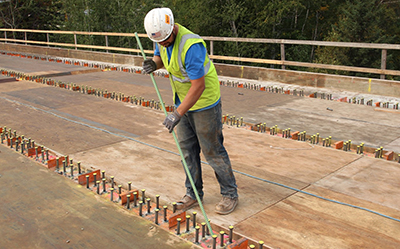
This worker breaks a ceramic insulator off a shear stud on the Hwy 61 Beaver Bay Bridge. The reconstructed bridge required the use of 8,382 shear studs, which make steel beams composite when buried in the new concrete bridge deck. Photo by Beth Petrowske, District 1
|
Northern Minnesota
- Hwy 2 Kennedy Bridge in East Grand Forks – Reconstruction of the Kennedy Bridge in East Grand Forks wraps up summer 2018, but crews made significant progress this year. Along with a brand new pier, the southern half of the bridge deck is complete. When finished, the bridge will feature a new layout that maintains four lanes of traffic and adds a protected walkway that connects the Greenway Trail on each side of the river.
- Hwy 9, Hwy 12, Hwy 29 in Benson – Work on two separate projects in the city of Benson were completed this season. The first project brought the city’s sidewalks up to Americans with Disability Act standards and upgraded the signal systems. The second involved resurfacing Hwy 9, Hwy 12 and Hwy 29 in and near the city.
- Hwy 10 railroad bridge and resurfacing in Detroit Lakes – Work will be completed in November on this project to replace the eastbound Hwy 10 bridge over the CP Railway line and resurface Hwy 10 in concrete from Hwy 59 to Summit Avenue.
- Hwy 10 in Glyndon – This project involved resurfacing the traffic lanes through Glyndon and installing center left turn lanes/medians for access control.
- Hwy 23 in West Duluth – This project reconstructed almost two miles of the highway, replaced two bridges, improved accessibility and included bike lanes and trail connections.
- I-35 Pine and Carlton counties – These projects included resurfacing approximately 10 miles of pavement, installing new guardrail and repairing a bridge.
- Hwy 53 relocation project in Virginia – The new alignment for the roadway and bridge opened in September, more than a month ahead of schedule. Crews are putting the finishing touches on the new highway, as well as removing the concrete pavement, the Second Avenue bridge, underground utilities and signs from the old alignment.
- Hwy 59 roundabout near Detroit Lakes – Crews constructed a roundabout at the Hwy 59/Becker County Road 22 intersection this summer. The work began in late spring and was completed prior to WE Fest.
- I-94 from Evansville to Garfield – Work this year included resurfacing 15 miles of eastbound I-94 and re-decking the eastbound bridges at Hwy 79 and Hwy 114. The westbound lanes and bridges will be completed next construction season.
- Hwy 210 in Jay Cooke State Park – The project was completed in September. Work began in May 2015 to resurface the roadway, which was washed out in a 2012 flood. During the construction, crews improved drainage and flattened slopes to help prevent future problems caused by flooding and erosion.
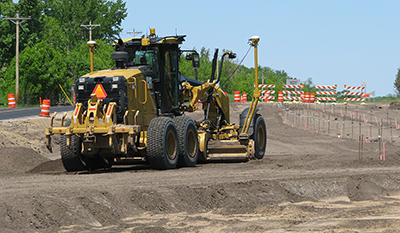
MnDOT opened its second roundabout in the Detroit Lakes area this summer at the intersection of Hwy 59 and Becker County Road 22. The contractor began work in early May and the project was completed on schedule by the end of July, just ahead of the area's popular WE Fest. Photo by Jerimiah Moerke, District 4 |
Central Minnesota
- Hwy 10 in Elk River – Project reconstructs the Hwy 10 bridge over Lake Orono and the road surface from Joplin Street/185th Avenue to Xenia Avenue. Work will continue through fall 2018.
- Hwy 24 in Clearwater – A new Hwy 24 bridge over the Mississippi River in Clearwater opened in August. The updated structure includes wider lanes and shoulders and improved pedestrian access on the route between Hwy 10 and I-94. The old bridge will be dismantled by June 2018.
- Hwy 169 in Aitkin – Constructed a new roundabout at Hwy 169 and Southgate/Red Oak Drive for improved safety and local access to retail shops in Aitkin.
- Hwy 371 Nisswa to Jenkins – Expanded Hwy 371 to four lanes from Nisswa to Jenkins. All four lanes opened Oct. 6 and include a new alignment and interchange at Hwy 371/County Road 11 in Pequot Lakes, Paul Bunyan State trail bridges and trail segments, and two reduced conflict intersections.
Western Minnesota
- Hwy 19 from Marshall to Vesta – Crews are nearing completion of a cold in-place recycle project. CIR, which is cost-effective and environmentally friendly, consists of milling in-place bituminous pavement, crushing the materials, adding oil, remixing it, followed by re-laying the materials with a paver and compacting it.
- Hwy 71/ Hwy 7 roundabout near Blomkest – A roundabout was constructed at the intersection of Hwy 71 and Hwy 7. The roundabout provides increased safety and reduces delay times, vehicle emissions and fuel consumption.
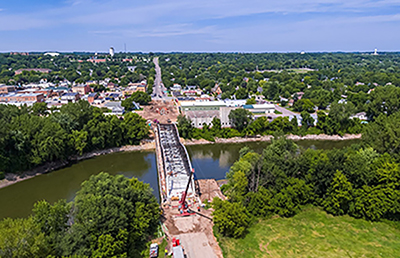
The rehabilitation of the historic Hwy 99 bridge near St. Peter will be complete in early December. Photo by Robert Jones |
Southern Minnesota
- Hwy 4 in St. James – This multi-year project includes reconstruction of approximately 1.6 miles of Hwy 4, including two new mini-roundabouts. Project will be complete in early 2019.
- Hwy 15 in New Ulm – Resurfaced deteriorating pavement, added center two-way left turn lane, repaired two bridges and made improvements to traffic signals and sidewalks.
- Hwy 22 Mankato to Mapleton – The Hwy 22 Victory Memorial Drive project will continue through 2019. The project includes repaving, bridge work, a roundabout and replacing trees that have to be removed for the project.
- I-35 and Hwy 14 bridge replacements – Five bridges were replaced near Owatonna, three on I-35 and two on Hwy 14.
- Hwy 43 Winona Bridge – The new bridge opened to two-way traffic in August 2016, while the existing bridge remains closed for rehabilitation work. The older bridge is expected to be completed between fall 2019 and spring 2020.
- Hwy 52 between Zumbrota and Rosemount – Resurfacing the northbound lanes and installing a cable median barrier was completed from north of Rochester to south of Zumbrota. A bridge replacement was completed at Hwy 58 over Hwy 52 at Zumbrota and two bridge replacements at the Little Cannon River on Highway 52 in Cannon Falls were completed.
- Hwy 63 Red Wing Bridge – Bridge piers are being built on the new bridge and the connecting ramp to Hwy 61 at Red Wing is under construction. Traffic will remain open on the bridge through construction. Work continues this winter with an anticipated opening in fall 2019.
- I-90 preservation projects – Pavement and bridge repairs occurred at several locations along I-90 in southern Minnesota. The project also made improvements to lighting systems and upgraded the Worthington weigh station.
- Hwy 99 Bridge in St. Peter – Rehabilitation of the historic bridge will be complete in early December. Traffic is detoured while crews finish final construction and painting of the bridge.
|
 |
|

|
 |
TABLE of CONTENTS
 |
Minnesota named second most bicycle friendly state |
By Sue Roe
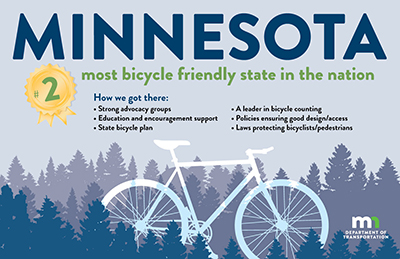
Minnesota has consistently ranked in the top five of bike friendly states since the rankings began in 2008. The League of American Bicyclists ranks states annually on a number of criteria, including infrastructure that provides safe places to bike. |
Minnesota is the second most bicycle friendly state in the nation, according to the League of American Bicyclists’ ranking released last week.
Minnesota has consistently ranked in the top five states since the rankings began in 2008. The number one ranking went to Washington state, which has had the top spot since 2008.
“In recent rankings, Minnesota has just been slightly behind Washington and at times it could be considered a toss-up for the top spot,” according to the Bicycle League’s report card. “MnDOT continues to do some excellent bicycle planning that enables state, regional and local collaboration that improves biking.”
“MnDOT and our partners work hard to improve the bicycling environment in the state,” said Amber Dallman, MnDOT’s bicycle and pedestrian coordinator. “We know there is always more to do to make bicycling safe, comfortable and convenient for all, but we are happy that our efforts are keeping us at the top.”
The Bicycle Friendly States ranking is based on a number of key indicators, including infrastructure and funding that provide safe places to bike; education and encouragement programs that promote cycling; and passage and enforcement of bicycle friendly laws that make it safe and comfortable for people of all ages and abilities to ride.
Rounding out the top five bicycle friendly states are California, Oregon and Massachusetts.
“One difference between Washington and Minnesota this year is that Washington recently secured long-term funding for bicycling and walking while Minnesota continues to have protracted transportation funding debate,” according to the report card.
Minnesota received its ranking in part because of its work in securing funding for bicycle district plans that align with the Statewide Bicycle System Plan. Recent legislation also clarified the safe passing law with the double yellow line. The state is also a leader in bicycle and pedestrian counting, something the League said will help lay the foundation for the role of bicycling and walking in the state’s transportation system.
The League’s report noted that Minnesota would benefit from laws that make it easier for local jurisdictions to lower speed limits on state roadways increase penalties for a motorist that injures or kills a bicyclist or pedestrian and require the use of a hands-free device for phone use while driving.
Minnesota has 21 bicycle friendly communities, 86 bicycle friendly businesses and four bicycle friendly universities.
Read more about the League of American Bicyclists’ rankings at www.bikeleague.org.\ |
 |
|

|
|

|
 |
TABLE of CONTENTS
 |
Transportation safety professionals attend annual TZD conference |
By Dana Hernandez

Jody Martinson, Operations Division assistant commissioner, thanks the Toward Zero Deaths coordinators for bringing the four “E’s” together to help shape Minnesota’s traffic safety culture. Martinson spoke at the annual statewide TZD conference held this year in St. Paul Oct. 26-27. Photo by David Gonzalez
|
The 14th annual Statewide Toward Zero Deaths Conference was held Oct. 26-27 at St. Paul’s RiverCentre. Stakeholders from across the four “Es” (education, emergency medical and trauma services, enforcement and engineering) were present in abundance during the conference’s keynote speakers and concurrent sessions.
During the opening session, Jim Hedlund, Highway Safety North, spoke on the promises and challenges of autonomous vehicles in relation to traffic safety. Hedlund reported that 94 percent of crashes are due to driver error. He posed the question: Will autonomous vehicles fix this problem?
The answer is a bit more complicated than a simple “yes” or “no.”
“As Yogi Berra once said, ‘It’s really hard to make predictions—especially about the future,’” Hedlund said.
There are different levels to autonomous vehicles, ranging from zero to five. In 2017, level two is currently available. Level two is occasional self-driving, meaning drivers may disengage from the steering wheel and the pedals, but still must be present and monitor the vehicle. According to Hedlund, levels three to five (five being fully self-driving) are coming soon.
You can read more about these topics in the Governors Highway Safety Association’s Autonomous Vehicles Meet Human Drivers: Traffic Safety Issues for States report.
“No automation vehicles and autonomous vehicles will share the road for a long time—perhaps forever,” said Hedlund.
So what should stakeholders do to work toward zero deaths on Minnesota roads with the introduction of AVs on our roads? Hedlund suggested we:
- Encourage AV testing while protecting public safety
- Develop AV laws and regulations
- Document safety issues of AVs
- Involve law enforcement
Hedlund’s presentation transitioned to a panel discussion, moderated by Jay Hietpas, MnDOT’s Office of Traffic Safety and Technology director and Minnesota TZD Program co-chair and director.
Panelists included Hedlund; Tom Henderson, Driver and Vehicle Services, Minnesota Department of Public Safety; Colonel Matt Langer, TZD Leadership and Minnesota State Patrol; and Bernie Arseneau, HDR Consulting and former MnDOT deputy commissioner/chief engineer.
Panelists discussed the new paradigm autonomous vehicles create and the need for more collaboration between the usual stakeholders and those entering the discussion.
“It’s time to be engaged and get excited about autonomous vehicles because they’re coming and they might save lives,” said Langer.
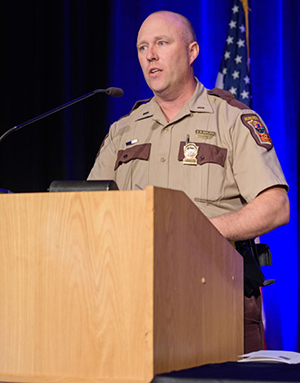
Lt. Brad Norland, Minnesota State Patrol, received the Enforcement Star Award at the 2017 Toward Zero Deaths conference Oct. 26. Norland is a leader in promoting traffic safety in the northwest region of the state. Photo by David Gonzalez |
The conference also featured a number of concurrent sessions, including one talking about what’s going on behind the scenes as Minnesota prepares to host Super Bowl LII in February 2018.
“It was standing room only in this session,” said Kristine Hernandez, statewide TZD program coordinator. “Minnesota hasn’t hosted a Super Bowl since 1992, so it’s exciting to see all the details that go into planning for safety.”
Session presenters included: Brian Kary, MnDOT Office of Traffic, Safety and Technology; Nadia Anderson, Uber Minnesota; Col. Matt Langer, Minnesota State Patrol; and Commander Scott Gerlicher and Steve Mosing, both with the city of Minneapolis.
Presenters touched on subjects like increasing law enforcement in Minneapolis, especially for bars having the option to stay open until 4 a.m. statewide, and how the city of Minneapolis will adjust for the influx of pedestrians and other visitors.
“This is not just about the game,” said Gerlicher. “There are 10 days of events leading up to the game, with an influx of about 1 million visitors in attendance.” Gerlicher reminded the audience that the Super Bowl will be like an expanded version of Vikings games, with similar closures and heavy reliance on transit.
Kary discussed the Regional Transportation Management Center’s role during the Super Bowl. RTMC will be able to use cameras and changeable message signs to ensure safety and traffic flow. Deploying snowplows is a main priority to ensure roads are clear of snow and FIRST trucks will be supporting State Patrol.
Kary noted that MnDOT plans to have a driverless bus to pilot in downtown Minneapolis as well.
The second day of the conference began with Safeguarding Our “High”ways: Combatting Drugged Driving, presented by Chuck Hayes, Drug Evaluation and Classification Program, project manager, International Association of Chiefs of Police.
“Drug-related crashes are on the up and up,” said Hayes.
The presentation focused on how drugged driving is more complicated than drunk driving. The differences are apparent in the data, where it’s limited for drugged driving and abundant for drunk driving. Hayes explained the culture differences between the two impaired driving situations, pointing out that it’s no longer socially acceptable to drive drunk.
“We’ve got a lot of work left to do,” said Hayes, who stressed the importance of increasing public education and training for enforcement surrounding drugged driving.
The session concluded with a video, Life without Lindsay: Sober Driving Matters. It was a story focused on Lindsay Cardinal who lost her life on Jan. 31, 2017, in Foley, Minn., due to a drunk driver. Her husband, Matt, was left to raise three children and described how an impaired driver changed his life forever. The video served as a reminder to those in the room why they strive towards zero deaths in their daily work.
Individuals, organizations receive recognition for safety efforts
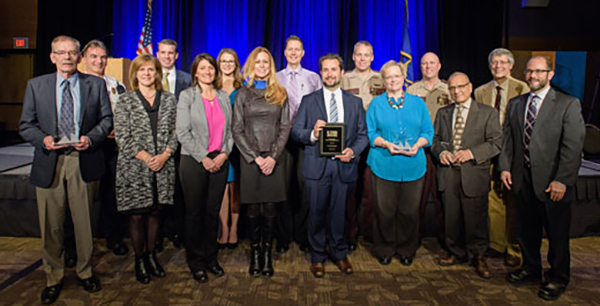
The 2017 Toward Zero Deaths award winners were announced during the annual statewide TZD conference Oct. 26. These awards are given to individuals or organizations in Minnesota who show excellence in TZD’s emphasis areas of enforcement, emergency medical and trauma services, education, engineering child passenger safety and judicial/court systems. They have shown their leadership and creative capacities in efforts to improve traffic safety throughout the state and also build partnerships with others in the field.
Twin Cities-area award winners:
- Child Passenger Safety Star Award – Julie Philbrook, Hennepin County Medical Center
- Distinguished Public Leadership Award – David Bernstein, DWI Task Force and Minneapolis Attorney
- Education Star Award – Vijay Dixit, Shreya R. Dixit Foundation
- Media Star Award – Tim Harlow, Star Tribune
- Traffic Safety Innovation Award – KARE 11 and Federated Insurance “#EyesUp Campaign”
Greater Minnesota award winners:
- Emergency and Trauma Services Star Award – James Kroona, Willmar Ambulance
- Enforcement Star Award – Lieutenant Brad Norland, Minnesota State Patrol
- Engineering Star Award – Rick West, Otter Tail County
- Judicial and Court System Star Award – Detective Matt Grochow, St. Peter Police Department
- Kathy Swanson Outstanding Service Award – James Dehn, Tenth Judicial District Court
Photo by David Gonzalez |
|
 |
|

|
 |
TABLE of CONTENTS
 |
Tribal-State Training representatives present at National Congress of American Indians |
By Judy Jacobs
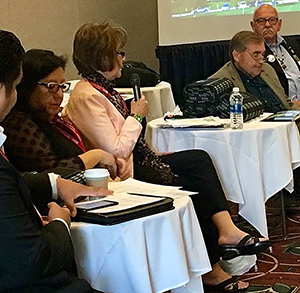
Linda Aitken, seated at a table, speaks to National Congress of American Indians in mid-October. Photo by Emily Johnson, Mille Lacs Band of Ojibwe |
Minnesota’s Tribal-State Relations Training program and team members received recognition during the National Congress of American Indians, held in mid-October.
“It is my honor to introduce a panel at NCAI today consisting of the Tribal-State Relations training program team of Linda Aitken, Tadd Johnson and Leroy Staples Fairbanks,” said Melanie Benjamin, Mille Lacs Band of Ojibwe chief executive. “This team has held 19 separate two-day trainings for state employees about tribal sovereignty, treaties, our history and how to deal respectfully with Indian tribes.”
Aitken, MnDOT Government Affairs, is the training program manager and enrolled member of the Leech Lake Band of Ojibwe. Johnson is the Graduate Studies program director, Department of American Indian Studies, University of Minnesota/Duluth and enrolled member of the Bois Forte Band of Chippewa. Fairbanks is the Leech Lake Tribal Council and District III representative.
The Tribal-State Relations training break-out session was one of the most heavily attended at the conference.
“It was an honor to present with the distinguished tribal leaders from Minnesota and other states,” said Aitken. “I enjoyed being in an electric atmosphere of professionals talking about, and working on, tribal sovereignty issues.
“We need to learn from each other and share best practices,” she said. “When we work with the tribal nations, we work better when we understand their history, culture, values and ways of life.”
Since the program began in 2013, almost 2,000 state employees have attended the Tribal-State Relations training representing the departments of Commerce, Corrections, Employment and Economic Development, Education, Health, Human Services, Natural Resources, Pollution Control Agency, Revenue and Transportation, as well as the Minnesota Housing and Finance Agency, Minnesota Management & Budget and the Governor’s Office.
In July 2016, the University of Minnesota’s Humphrey School of Public Affairs honored the Tribal-State Relations Training with an award for demonstrating commitment to offering creative, efficient services for Minnesotans. It was one of the top three winners of the State Government Innovation Award.
“As a result of Tribal-State Relations Training, our leaders within MnDOT have gained greater awareness and sensitivity that helps our ongoing interactions with tribal nations as we plan and implement programs and projects for our mutual benefit,” said Commissioner Charlie Zelle. “I found the training intriguing by learning a history I had not fully appreciated despite living in Minnesota my whole life.”
The next training session will be hosted by the Shakopee Mdewakanton Sioux Community at Mystic Lake in Prior Lake Jan. 8-9, 2018.
|
 |
|

|
 |
TABLE of CONTENTS
 |
Land Management holds 25th Right of Way Professionals Workshop
|
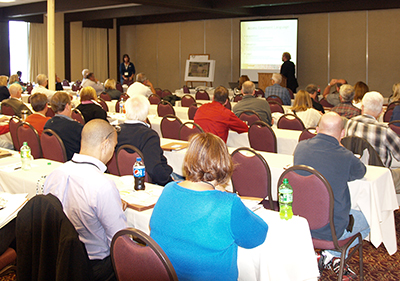
The Office of Land Management hosted its annual Right of Way Professionals Workshop Sept. 20-22 in Brainerd. Photo courtesy of the Office of Land Management
|
The Office of Land Management hosted the Right of Way Professionals Workshop Sept. 20-22 at Cragun’s Conference Center in Brainerd. It was the 25th year the event was held.
“What began as an information sharing event in 1993 for MnDOT employees has grown into an event that has proven to be of value to MnDOT and our public and private sector right of way professional partners throughout Minnesota,” said Cheryl Hunstock, training coordinator, Office of Land Management.
The workshop, which had 270 participants, included various appraisal, purchasing, relocation, legal and real estate topics.
“Over the years we have had the good fortune to have many talented and knowledgeable speakers contribute to the quality of the workshop program,” said Hunstock.
More information can be found on the Office of Land Management website.
|
 |
|

|
 |
TABLE of CONTENTS
 |
State agencies to hold Fraud Awareness and Prevention Week, Nov. 12-18 |
Gov. Mark Dayton has proclaimed the week of Nov. 12-18 as “Fraud Awareness and Prevention Week in the State of Minnesota.”
Fraud is an expensive burden on Minnesotans and affects state agencies as well as taxpayers. MnDOT’s activities to raise awareness about fraud and what employees can do to prevent it include:
- Posters set up throughout the agency
- Weekly e-mails
- Fraud Awareness and Prevention Webinar offered on Tuesday, Nov. 14, 9 – 10 a.m., and Thursday, Nov. 16, 2 – 3 p.m.
For more information see the Safeguarding MnDOT iHUB page. |
 |
|

|
 |
TABLE of CONTENTS
 |
On the job: Becky Vernier uses mobility assignment to advance WIG 2.0 employee retention goal |
By Judy Jacobs

Photo by JP Gillach, District 3 |
|
Do you or a co-worker have an interesting job to share with readers? Send us your ideas, and we’ll contact you for more information.
Recent employee profiles:

|
|
| |
|



